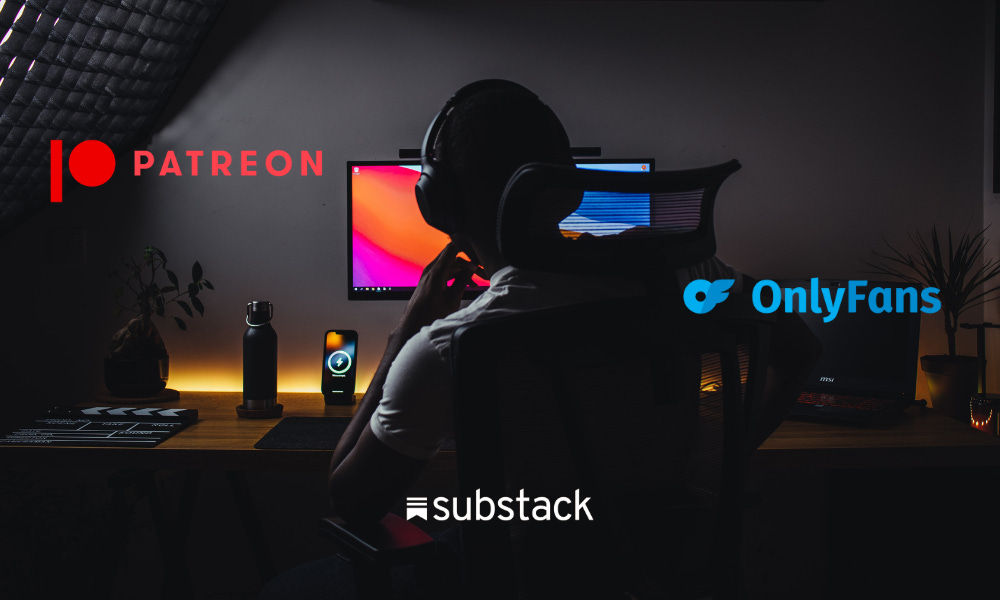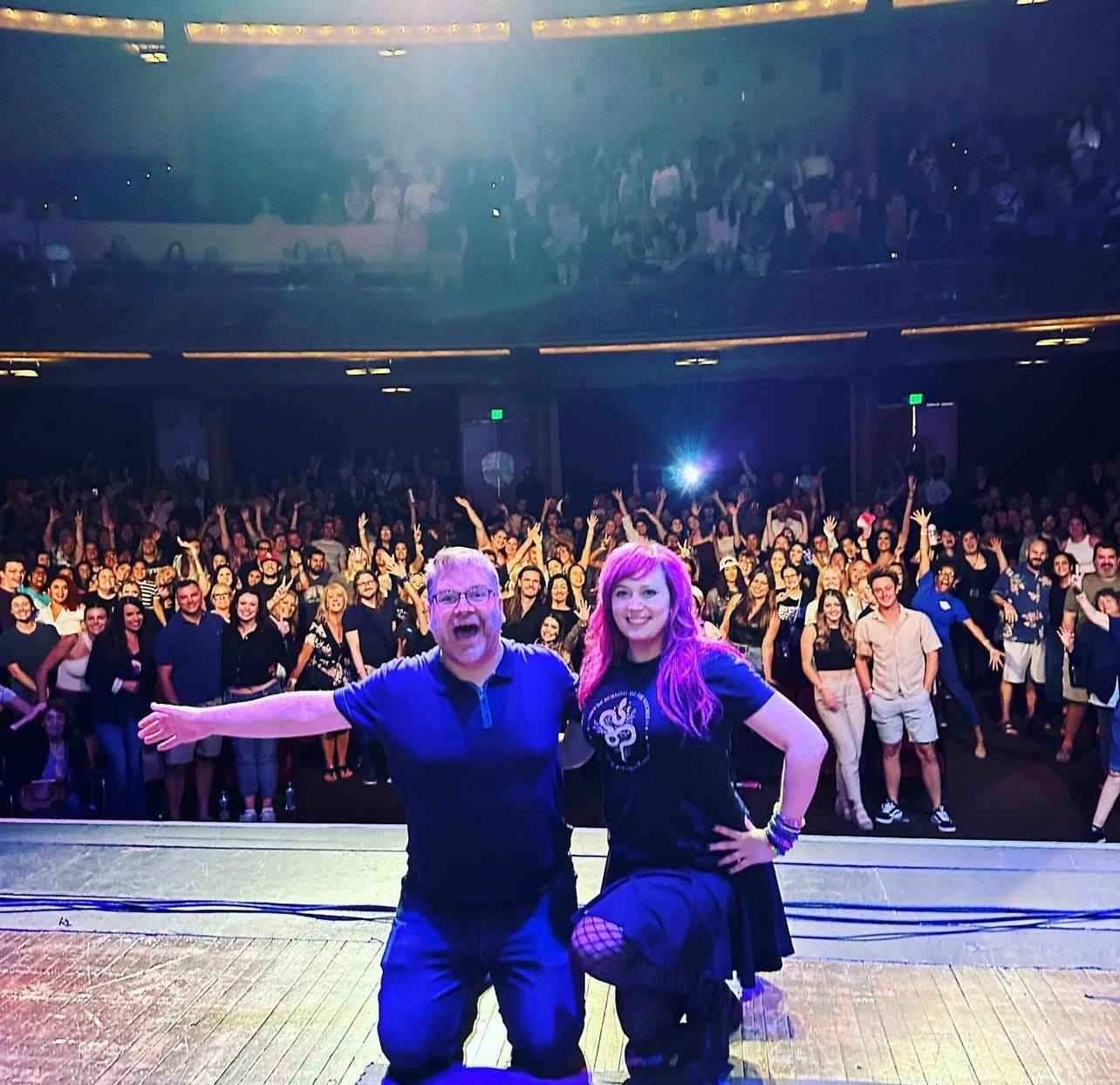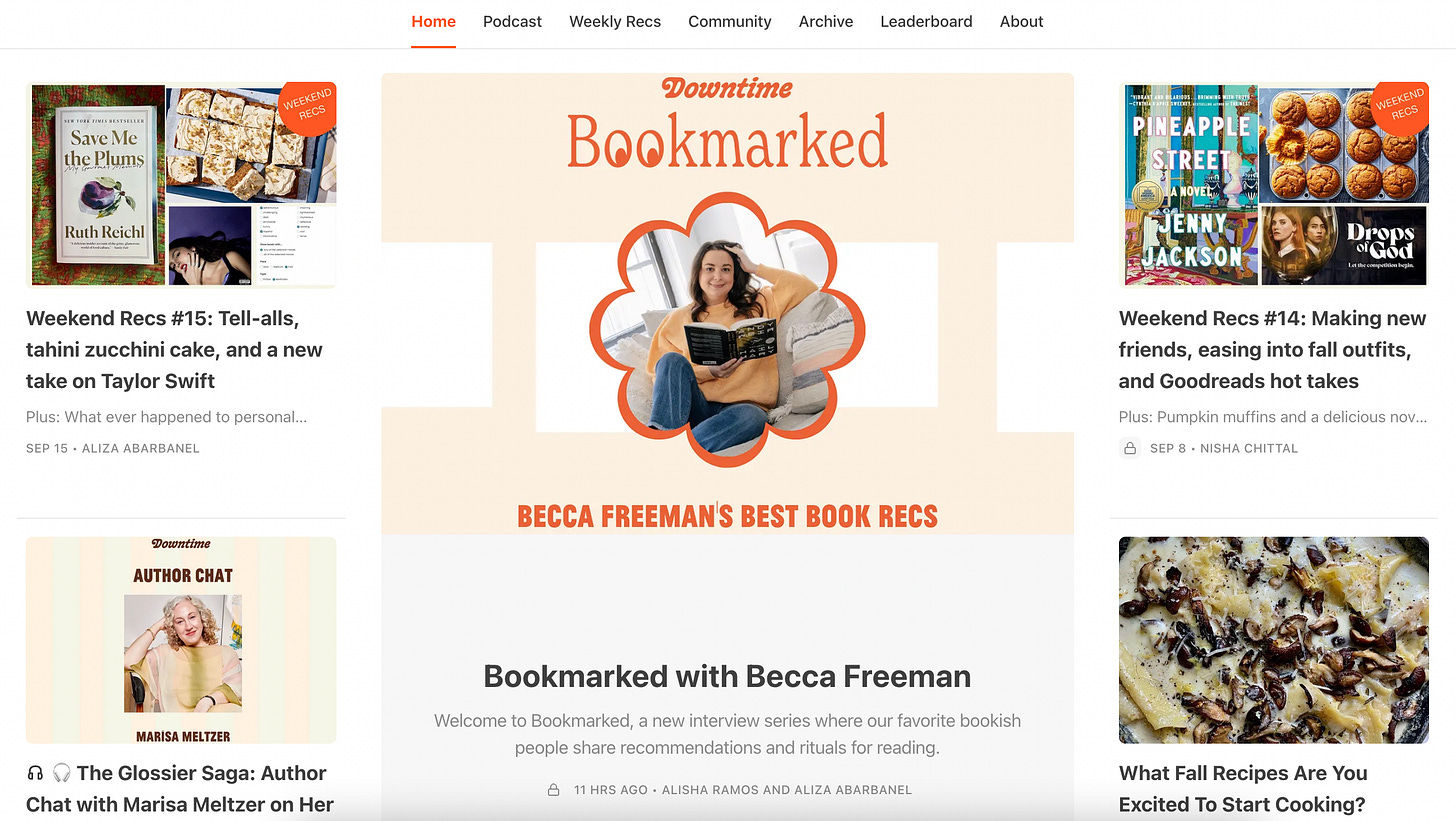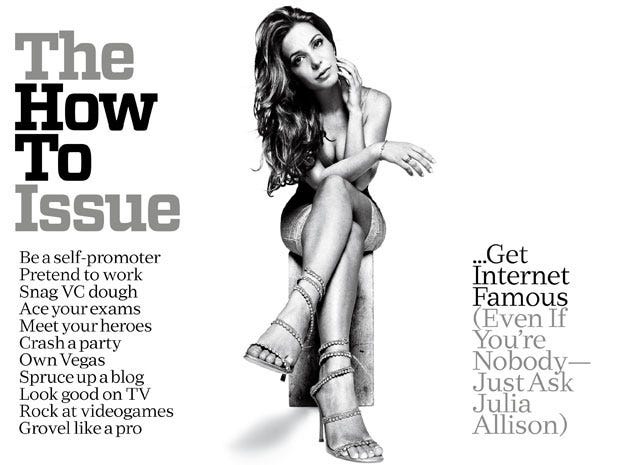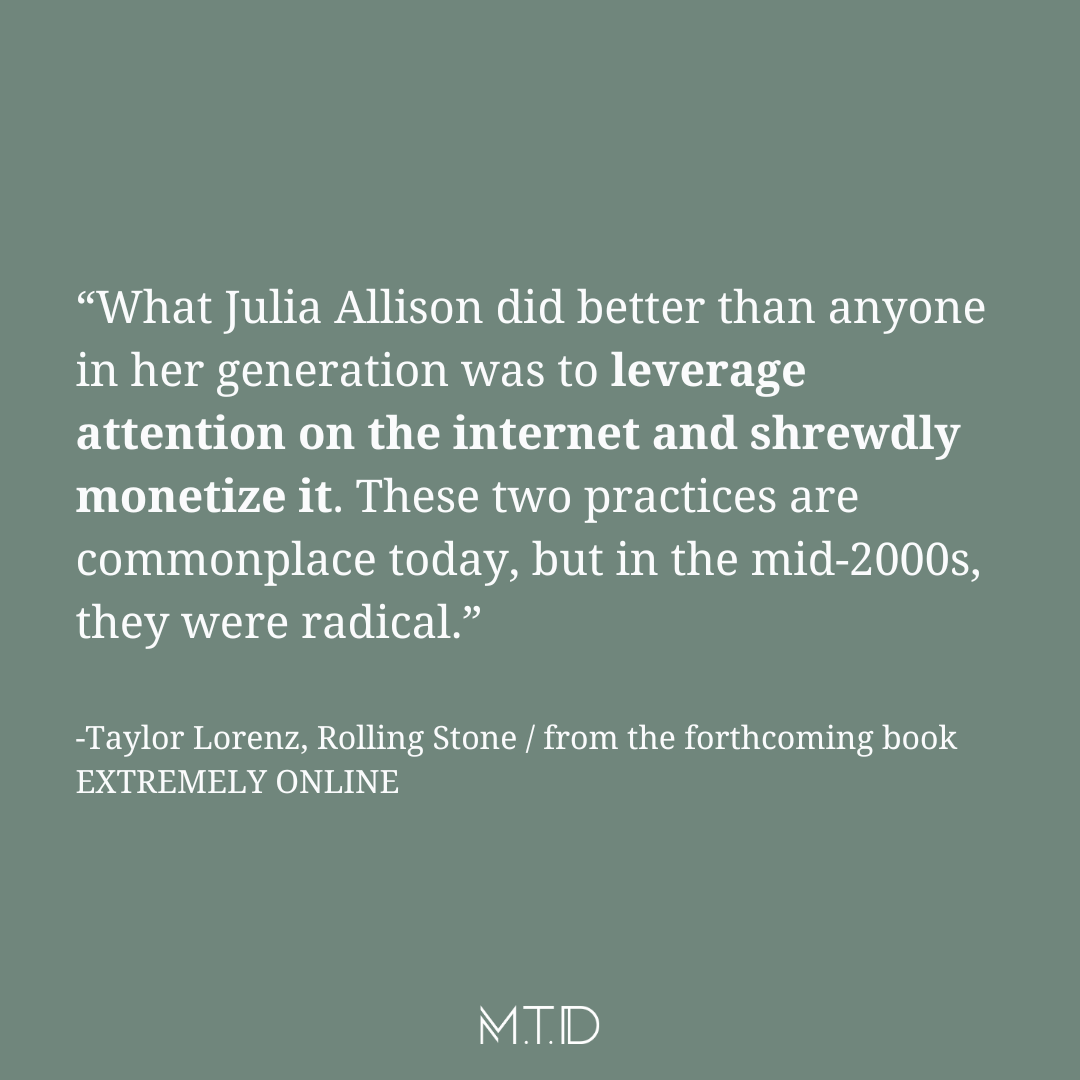How Patreon, Substack or even OnlyFans could fit into your digital strategy
+how the original influencer built her brand and the cultural moments | news that caught our attention this week
quick summary ⚡️
Breaking down 3 platforms [Patreon, Substack, & OnlyFans] dedicated to putting money directly into the hands of their creators
A look back at Julia Allison - “In the mid-2000s, Allison dominated the online world as one of the first multi-platform content creators.”
TikTok’s latest trend around Ancient Rome, the important art of naming group chats and more in the cultural moments and news that caught our attention this week
Creators are slowly but surely starting to embrace AI
platforms that can strengthen your community and make you $$$
Kait Richmond is a writer, producer and contributor to the M.T. Deco Blog
Picture this: you’ve done the work to create your digital strategy, and it’s thriving. Your audience is growing, engagement is up, and you feel passionate about the content you’re creating. The next logical step, you might be thinking, is when will I see this work literally pay off?
Today we’re talking about the platforms dedicated to putting money directly in the hands of its creators. Yes, social media is a great place to start, and we’ll touch on some of the ways those companies are helping people earn $$$, but our readers and clients know the value of owned platforms, and that value extends to earnings.
It’s no surprise that more of these platforms are popping up, but the big ones are Patreon, Substack and OnlyFans (hold your judgment on that last one - we’ll get into why shortly). These platforms let creators control what they earn for their content, while taking a cut (5-12% from Patreon, 10% from Substack and 20% from OnlyFans).
Here’s a quick cheat sheet if you’re not familiar with the platforms we’re talking about:
Patreon: The platform gives creators the opportunity for fans to subscribe for exclusive content (podcasts, videos, etc.). Forbes recently reported that “there are currently more than 200,000 active Patreon accounts and millions of patrons who support these members.”
Substack: This email newsletter platform (which has recently started hosting podcasts) is a popular choice among writers, despite some ups and downs since launching in 2017. [Subscribe to M.T. Deco’s #ForYou Substack!]
OnlyFans: Believe it or not, OnlyFans isn’t just for NSFW content. While the platform does cater to sex workers, there are many others who are trying it out, including athletes and chefs. And the company started OFTV, which highlights OF creators through strictly safe-for-work series.
Now that you’ve got the lay of the land, let’s talk about the creators on these platforms.
Patreon: Patrick Hinds and Gillian Pensavalle
The hosts of the True Crime Obsessed podcast used Patreon to take their show from side hustle to full-time job.
"I coined the phrase 'Patreon is freedom,' because within four months of us launching our Patreon, both of us had quit our jobs," Patrick told Business Insider in 2021. "Gillian has a family. I have a family. It's not a thing we did lightly. But we knew it was sustainable."
TCO started as an ad-supported, free podcast on Apple and Spotify. When the hosts started their Patreon account, subscribers paid $5 per month for about four extra ad-free bonus episodes a month. Today, there are pricing tiers (up to $20 per month), and the content has expanded to include videos, chats and livestreams.
Substack: Alisha Ramos
Alisha gained notoriety in 2017 as the founder of the popular Girls Night In newsletter. It quickly became popular thanks to its self-care recs and supportive community.
Recently, Alisha made the decision to revamp the newsletter, calling it
and moving it over to Substack. There are already 140,000 subscribers, and Alisha was mentioned in Vanity Fair as one of the platform's heavy hitters.“Based on our reader survey, LOTS of you mentioned missing the community feeling of the newsletter, so I'm excited to try out Substack, which has some classic blog-like features that can help like comments, discussion threads, and more,” Alisha wrote in the Downtime announcement post. “You’ll still get the newsletter in your inbox like always, but readers who want to be a bit more involved can now do that.”
OnlyFans: Whitney Cummings
What better place for a comedian to push boundaries than OnlyFans? Whitney Cummings saw the opportunity and jumped on it in 2022, and remains active today.
When OF announced that Whitney would be joining the platform, she told Variety: “I know people like to make fun of [OnlyFans] because there are naked ladies on there… I just decided, if the audience is going here, as a comedian there’s something worth checking out here.”
“I want to experiment with jokes,” Cummings told Variety. “I love the idea of writing and performing incendiary jokes… and talk about what is happening right now. On Twitter, people will want to take it out of context.”
more on strategically using Patreon, Substack and OnlyFans in your digital strategy on the MTD blog
“she invented being an influencer - and was vilified for it.”
Before there was the $100+ Billion creator economy [source: Insider Intelligence], there was Julia Allison’s blog and Tumblr.
As detailed in
’s upcoming book ‘Extremely Online,’ despite the constant misogynistic and unfounded attacks leveled against Julia from the media and being branded as an “internet fame-whore,” Julia grew a dedicated online fandom. From attending the World Economic Forum and the White House Correspondents Dinner to brand deals with major companies, Julia was [and still is] a force to be reckoned with.Despite her success, the constant attacks eventually led to Julia leaving the internet. But don’t worry, she’ll be back.
“I do intend and pray to come back to the internet someday, even if it’s as a grandma on TikTok. I will come back and be like, F*** you all! But I’m still building up to that point.”
more on Julia Allison in Rolling Stone
💎cultural gems💎
The cultural moments and news that caught our attention this week:
People are streaming pirated movies on TikTok, one short clip at a time (WSJ). Anyone else get sucked into watching movies on TikTok? I’m on part 33 of My Big Fat Greek Wedding.
How often do men think about ancient Rome? Quite frequently, it seems (Washington Post). TikTok’s latest trend consists of asking men how often they think about Rome. Surprisingly [for women], the average answer is multiple times a week.
The digital natives taking on big tech (Jules Terpak). Creator Jules Terpak sat down with co-chairs of Design It For Us, Zamaan Qureshi and Emma Lembke, to discuss the current state of social media legislation regarding kids and teens.
Taylor Swift sends Swifties scrambling with ‘1989 (Taylor’s Version)’ vault teaser (Rolling Stone). “While it’s all speculation for now, even Google is getting in on the games. A search for “1989 (Taylor’s Version)” leads fans to the official Google Search blog page where a resident Swiftie has organized an official easter egg hunt for the vault track titles and features.”
For a deep dive on the marketing genius of Taylor Swift, head to the MTD blog
will AI transform the creator economy?
While it’s too soon to tell how big a role AI will play in the creator economy, more and more creators are starting to use it with 51% wanting to try AI this year.
By far, the most common way creators are using AI is to edit and refine their content, followed by generating written and graphic content.
According to Hootsuite, the most popular AI platforms among creators include:
ChatGPT for copywriting and editing
Hootsuite for generating captions
Magic Studio for generating images
more on the creator economy from ConvertKit x tips on using AI to enhance your digital strategy x how to use ChatGPT to optimize your digital team here





